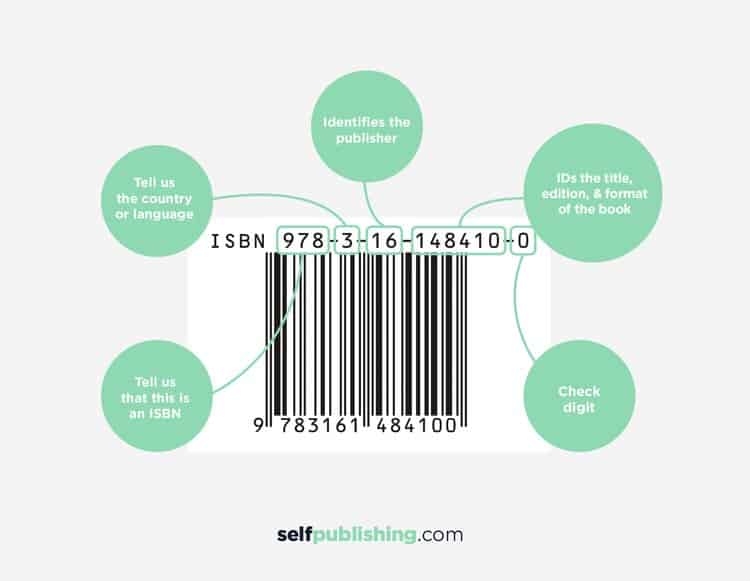
Figuring out how to get an ISBN number for a self-published book may sound scary, but it’s actually more simple than many authors think!
If you’re self-publishing a printed book, the best action you can take is to get your own ISBN as a self-published author.
Regardless if a book was self-published or traditionally published, every printed book needs an ISBN, and securing this number is a big step in your publishing endeavors.
But, many writers that are just taking the first step toward becoming an author still have a lot of questions about this topic.
Questions like…What is an ISBN number? How do you get an ISBN number for a self-published book? Do I buy one or just get it for free through KDP or an aggregator? How much does an ISBN cost? Are ISBNs for big-name publishers only?
In this post, we want to answer the commonly asked questions about ISBN numbers for self-published books, as well as everything else you need to know to buy, register, and imprint your ISBN.
As you read through these questions, we encourage you to open up these two websites in different tabs:
There is a wealth of information on those sites regarding ISBNs (including how to buy an ISBN number for your self-published book) that we will cover while going through these questions.
Now, before you start thinking about ISBN numbers, let me ask you this: Do you have a book ready to publish? If not, you can start preparing for an ISBN now, but you’ll definitely want to finish writing your book first!
Let’s start with the most basic question: “What is an ISBN number?”
ISBN, which stands for International Standard Book Number, is an internationally-recognized, 13-digit number that’s used as a unique identifier for books. Each individual book, specific book edition, and any other book-like product must have an ISBN number in order to be printed and distributed in retail bookstores, libraries, and wholesale companies. This number can be used to identify the book’s code digits, language, publisher, book title, edition, and format.
ISBN numbers are not required for eBooks, and for books that will not be available in stores or libraries.
In the days of WW2, MI6 recruited a young mathematician named Gordon Foster to work as a codebreaker, where he scanned millions of numbers looking for patterns in the code used by the Japanese military.
Decades later, when the book industry needed a standardized tracking program to organize the growing number of titles being published every year, Gordon Foster was approached by British retailer, WH Smith. He hired Foster to write a report on how to create such a system.
And this report ultimately led to the ISBN system that is now used worldwide.
ISBN numbers can be acquired by any publisher. And a self-publisher is a publisher, so yes! You will apply for an ISBN like anyone else. Refer to myidentifiers.com or keep reading to learn how to get an ISBN number.
ISBNs are issued based on location.
If you live in the United States, you can purchase an ISBN through Bowker, which is the only company authorized to administer ISBN numbers in the US.
In Canada, where the ISBNs are issued for free, you can visit the ISBN Canada—Library and Archives website.
Living in the UK, Ireland, or a British Overseas Territory, check out Nielsen ISBN Store.
For other international authors, you can visit the International ISBN Agency.
| If you live in…. | Go to: |
| United States | myidentifiers.com |
| Canada | ISBN Canada—Library and Archives |
| U.K., Ireland, or a British Territory | Nielsen ISBN Store |
| Anywhere else internationally | International ISBN Agency |
Note: While ISBNs are assigned locally, you can use them internationally.
No, you don’t need an ISBN if the book is available in other countries – as long as it appears in the same format and language.
However, you DO need an ISBN for each format and edition of the book. This includes publications in different languages. Refer to the International ISBN Agency for a list of language codes.
As a self-publisher, you have two options. You can either buy an ISBN number for your book(s) or obtain one for free through your self-publishing platform.
If you’re a resident of the United States, you can purchase an ISBN through Bowker by following the step-by-step instructions above. Or, you can obtain one for free via Amazon’s KDP or by uploading to Draft2Digital or SmashWords.
Regardless of how you get an ISBN number, it’s important to note that you only need one ISBN number per book. This is registered to your self-published book and stays with the book – regardless of the different stores or platforms, it’s sold on.
Due to the large volume of eBooks now published each year, all ISBN numbers are now 13 digits. All ISBN numbers issued prior to 2007 were 10 digits long.
Note: Older ISBN numbers with only 10 digits can now be converted into a 13-digit code with the ISBN conversion tool from Bowker.
An ISBN is the standard ID number used to identify books by booksellers, libraries, book wholesalers, and distributors.
It is used to identify each published book and each edition of the same book, as well as the publisher of the book. You can tell a lot about a book, its author, and the publisher by knowing how to read the ISBN number.
Let’s use the picture here to show you how it works in practice.

The 13-digit ISBN number is broken up into 5 parts that identify the following:
There are several ways to look up the ISBN number of a book, both on the book itself and online. Here’s how to find an ISBN number of any book:
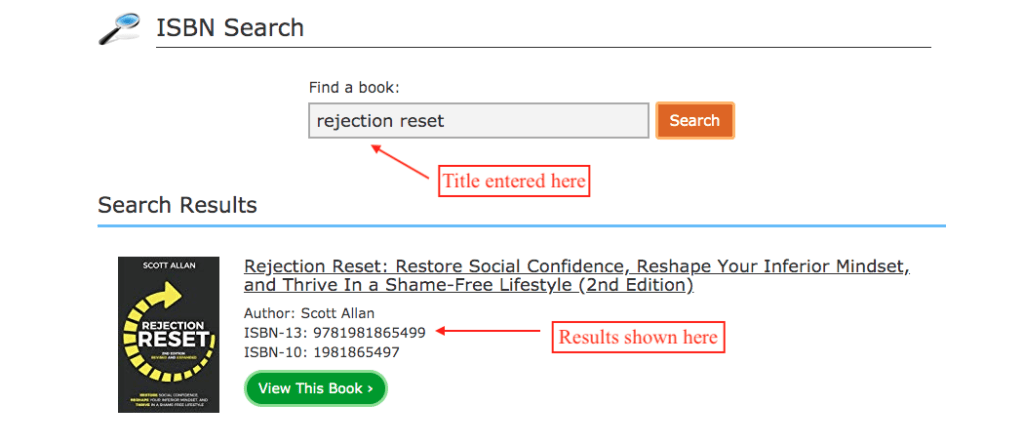
You can easily find the ISBN of your book using the same online tool.
To look up your book’s ISBN number, follow these steps:
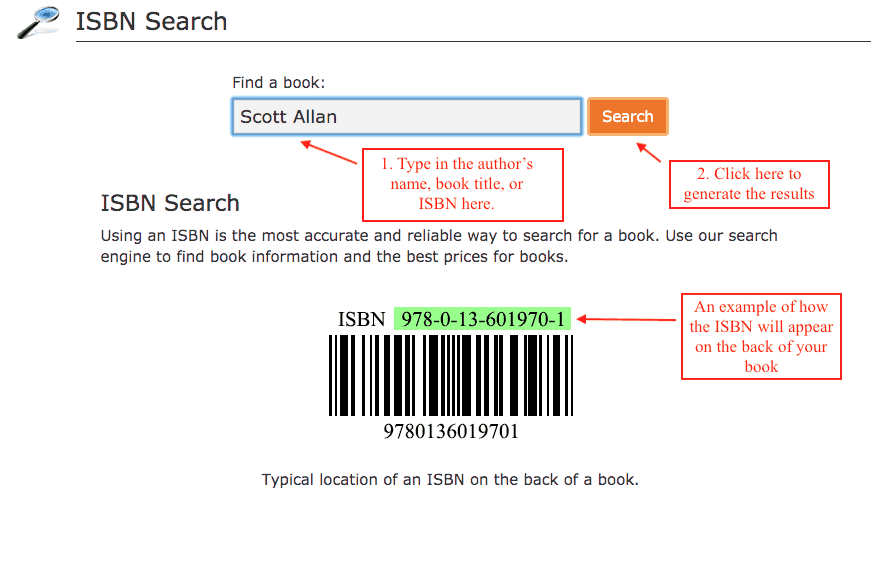
Yes, your self-published book should have an ISBN if you plan to sell your printed book in bookstores and libraries, through Amazon self-publishing, and/or online retailers and book aggregators.
There are limitations to this. For eBooks, a book ISBN number is not needed, except for certain exceptions, like if you publish through digital online distributors/aggregators. For example, Draft2Digital requires your book to have an ISBN. Although they will provide you with an ISBN for free, we recommend buying your own, for reasons explained further down in this post.
Here are the top reasons to buy an ISBN for a self-published book:
In short, it doesn’t matter if you are writing a children’s book or a nonfiction book. Your printed book needs an ISBN if you envision it in the bookstore or on the shelves of your local library.
If you are only publishing an eBook, and you have no plans to write and publish anything more, you won’t need an ISBN.
Or, if you are happy to only publish through Amazon KDP (print edition) and not use other online retailers, you can request a free ISBN book number via Amazon.
No, ISBN is administered by a private company for the use of the international book trade, while copyright is administered by the Library of Congress and is an extension of intellectual property law.
No, you can obtain an ISBN for your book even if it is not published yet.
ISBNs are issued to publishers, who then assign them to individual books. This can be done at any time, even before the book is written.
Yes, you can register your ISBN number once it is approved.
Once you have received your number, you should register it at Bowkerlink. Bowker hosts about 12 million international titles, and registration with them places your book in their massive bibliographic database.
No. A single ISBN can be issued for each book only.
For example, if you publish your book in paperback, hardcover, and eBook versions, a separate ISBN number is required for each format.
It is one ISBN per book only, and once assigned to a book, an ISBN number can never be reused.
ISBNs will need to be changed if certain changes are made to your book. This can be summarized into these 6 common changes and updates:
Essentially, any changes to the book that makes it appear as a “different product” would require a new book ISBN.
It’s important to note that not all changes require a new ISBN number.
Here’s a guide you can use to determine whether or not you need to buy another ISBN number for your book:
| Changes Made to Book: | New ISBN needed? |
| Printed in a variation, such as large print | Yes |
| Published in a different format | Yes |
| Published in a different language | Yes |
| Additional content added, like more chapters | Yes |
| Title and/or subtitle changed | Yes |
| Binding changes | Yes |
| Published in a new size | Yes |
| Increase or decrease book price | No |
| Create a new cover design | No |
| Switch to a new distributor or printer | No |
| Minor edits and corrections made to content | No |
If you only make line edits or correct typographical errors and don’t make any substantial changes and/or additions to the text, this is considered a reprint, and you don’t need a new ISBN number.
A new edition would contain a significant amount of new material, a major revision, or the addition of completely new chapters and/or sections. Anything that makes it a ‘new book’ is likely to create a new edition. Therefore, a new ISBN would be required.
You can continue to use the same ISBN if the cover is changed.
But if you change the title and/or subtitles and you will have to launch the print version of the book as a new title again, as this is recognized as a different book.
No, you really don’t want several ISBNs for your book. This can become a tangled mess and looks unprofessional. But it can happen when several retailers issue free ISBNs for the book.
Online aggregators such as Draft2Digital and Smashwords free ISBNs are not transferable. So, if they are issuing a free one, it is exclusive to that site only. This is the same with Amazon.
The best solution? Buy your own ISBN (more on that later). When you buy your own, the same number is used for that format no matter where it is published.
The price of ISBN numbers varies and you can buy single ISBNs or a bundle of them. The going rate for a single ISBN costs $125, while 10 ISBNs cost $295, 100 ISBNs cost $575, and 1000 ISBNs cost $1500.
The most affordable option is to buy one single ISBN number on Bowker.
But just remember, if you ever publish another edition of your book, or another book entirely, you will need more than one ISBN. Therefore, buying multiple ISBNs at once could save you a lot of money over time.
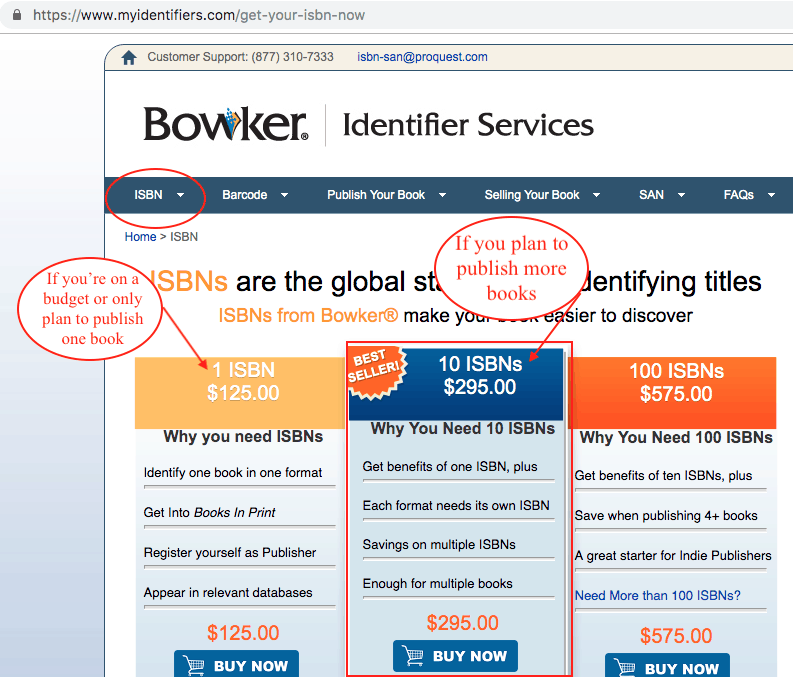
Note: that these prices are based on the price listings at Bowker for those living in the United States. For ISBNs purchased internationally, prices do vary (and are often cheaper).
Deciding how many ISBNs to buy is a personal decision and depends on your publishing goals. If you are a busy author publishing a new book every 4-6 weeks, in multiple languages and several formats, it would be smart to buy 100 ISBN numbers from the onset.
Remember that ISBNs do not expire.
And, consider if you use 3 ISBNs for each book in one language, you could use up a block of ten very quickly if publishing regularly.
The number of ISBNs you should buy also depends on whether or not you are assigning an ISBN to your eBook as well as printed versions. Although eBooks are not, at this time, required to have an ISBN, it does look more professional.
If you write one book and you don’t have plans to do any more, one ISBN will probably do. But for career authors, you should begin with the end in mind.
If you live in Canada, ISBNs are issued for free. If you live in the United States, you can get your book’s ISBN for free through your self-publishing platform, such as Amazon and Draft2Digital.
The main advantage is…it’s free. This can be convenient if you’re publishing on a budget. Or if it’s difficult to obtain an ISBN in the region you live in.
The disadvantage of receiving a free ISBN:
If you can, we recommend buying your own ISBN.
If you are in the US, you purchase through Bowker, or if you’re in the UK, you purchase through Nielson. Both sites make it very easy to buy ISBNs. Depending on your international location, you could go through a lot of red tape to get your book ISBN number, but most authors agree it’s worth the trouble.
Yes. If you want to stock your book in libraries, you’ll need an ISBN that you purchased and registered.
The library market is huge, and, if you are serious about expanding the distribution of your book, this is not an opportunity you want to pass up.
Overdrive is the biggest supplier of eBooks to libraries and has circulated over 105 million+ books to date to libraries.
Again, a free ISBN will not do. The ISBN number needs to be registered to a publisher – that would be you as the author (or your self-publishing company).
You’ll print it on the copyright page, and it’s included in the Cataloging-in-Publication data block if you use one.
Otherwise, just print it on the copyright page and on the back cover as part of the barcode.
The ISBN and barcode are different. Although both are found on the back of the book in the same place, they both fulfill a different function.
The ISBN is found above the barcode on the back of the book. And by now, you can answer the question, “What is an ISBN number?“
The barcode is a representation of the ISBN in a form that can be identified by scanners. It includes extra information such as:
Here are some facts about barcodes and ISBNs according to Bowker:
The standard barcode is known as the EAN (European Article Number) barcode and your barcode must be in this format to sell your book in bookstores.
An ASIN is not the same as an ISBN. ASIN is a number used by Amazon to identify products, whereas ISBN is the universal number for identifying a book.
ASIN numbers are only used by Amazon to manage and identify the products they are selling. It’s a 10-character alphanumeric unique identifier that’s assigned by Amazon.com only.
If you want to sell through other platforms—or in brick-and-mortar stores— you’re going to need an ISBN.
You can find this ASIN on your book page. In your browser, the Amazon ASIN will be after the product’s name and “dp.” The next place to find this is in your book or product details area of your book page.
Note: ASIN numbers are exclusive to Amazon, are non-transferable, and cannot be used in place of an ISBN.
According to Publisher Services, an official US ISBN Agency Partner:
“An EAN—which begins with the Bookland prefix 978—is called a Bookland EAN code and is used on books and book related products internationally. The Bookland symbol is the barcode of choice in the book industry because it allows for encodation of ISBNs (the numbers publishers use to identify their products).”
Since an ISBN is unique to one particular title (or product), the corresponding Bookland EAN symbol is a title-specific marking that is unique for that title.
For example, if a title is available in hardcover, softcover, and as an eBook, three unique ISBN Bookland EAN barcodes are required.
No, it’s not a good idea to use a free barcode-generating tool, and we do not recommend it to authors.
Here’s why: While it’s a tempting way to save money while self-publishing, many free barcodes are created with unreliable bitmapped images. They run the risk of not scanning when your book is being purchased. And you won’t be saving money if the barcode can’t be scanned properly.
For peace of mind, always pay for your book barcode(s) through a reliable source.
Yes, the ISBN and barcode are sold separately. But, the barcode cannot be purchased without the ISBN being bought first.
You need an ISBN to get a barcode, but you don’t need a barcode to publish a book.
Bowker offers an ISBN and barcode savings pack. It is a great value if you want to save some money and make it easier for setting up your ISBN and barcode together.
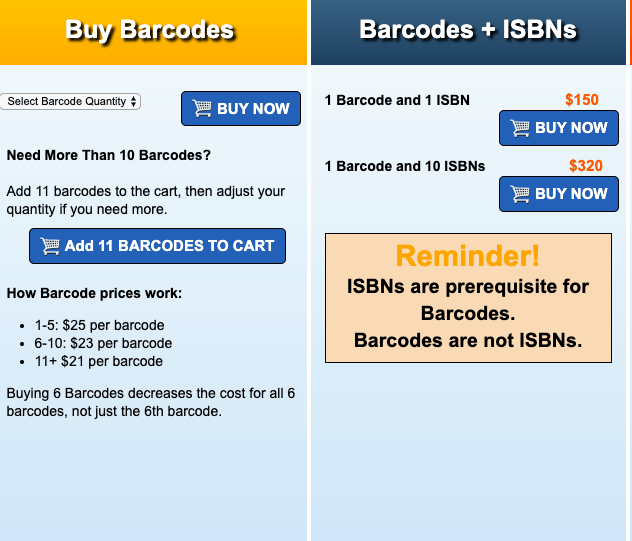
As we have mentioned throughout these questions, there are several best resources for finding out everything on ISBNs, including how to buy and set up for your book.
That’s it! You’ve reached the end of our frequently asked questions about ISBNs.
If you’d like for experienced publishing professionals to handle the entire process of getting an ISBN for your book, we can do that for you! Discover how SelfPublishing.com can help you publish your book!
Now you know exactly how to get an ISBN number for your self-published book, why it’s important, and if you actually need it.